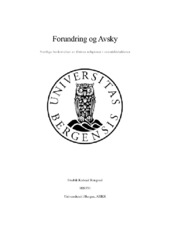Forundring og avsky: Vestlige beskrivelser av østlige religioner i senmiddelalderen.
Abstract
Den mongolske invasjonen av Øst-Europa i 1241 utløste en rekke diplomatiske oppdrag fra Europa til det mongolske hoffet. Opp til 1368 og Yuan-dynastiets fall i Kina reiste flere på lignende oppdrag mot Øst med forskjellige motiv: handel, misjonering eller diplomati. På deres reise ble de reisende konfrontert med nye og fremmede kulturer med praksiser og tradisjoner som var forskjellig fra noe de hadde sett tidligere. Denne oppgaven søker å vise hvordan beskrivelser av østlige trosretninger utviklet seg innenfor fransiskanske reisefortellinger mellom 1241 og 1368. For et komparativt perspektiv vil oppgaven bruke reisefortellingene til handelsmannen Marco Polo, dominikaneren Jordan Catala og den marokkanske muslimen Ibn Battuta. The Mongol invasion of Eastern Europe in 1241 ignited a series of diplomatic missions from Europe to the Mongol court. Up until 1368 and the fall of the Yuan dynasty in China, several traveled on similar missions to the East with various motives: commerce, missionary or diplomatic. On their journeys, the travelers encountered new and strange cultures with customs different from what they were used to. This thesis aims to document how descriptions of Eastern beliefs developed within the Franciscan travel literature between 1241 and 1368. In a comparative view, the thesis will use the travel writing of the merchant Marco Polo, the Dominican Jordan Catala, and the Moroccan Muslim Ibn Battuta. To show how these descriptions of Eastern beliefs developed, the thesis will argue that the development of the Franciscan educational system explains why the later Franciscans have a holistic worldview. This development in the educational system made the Franciscans able to construct this holistic worldview, but the Pope's involvement, both direct and indirect, was the decisive factor in how the descriptions of Eastern beliefs developed. The Pope's establishment of the Eastern archiepiscopal sees in Khanbalik and Soltaniyeh created a foothold for the missionary work of the mendicant orders in the East. Through the doctrine of contra naturam and the bulls cum hora undecima, the eschatological motivation behind the missionary work of the Mendicant Orders was pushed to the forefront. They became sure that the end was near, and had to convert the obis terrarium into the coming orbis Christianus. This affected the discourse on the beliefs of the East in a way that the later and better- educated Franciscans could construct a holistic worldview. In addition, the expansion of knowledge of eastern beliefs explain how the different levels of contrast between unfamiliar and well-known religions developed within the period of 1241 until 1368. Here, the development of the Franciscan educational system makes a greater impact, where training made them capable of singling out wrong" doctrinal and ritual practices. This time period of cultural exchange and the Europeans discovery" of the Eastern religions ended with the disintegration of the Mongolian empire in the 1370s. Not until the 1490s and the Age of Discovery will this exchange open once more, and then the stories from the late Middle Ages are dusted of to inspire a new generation of ethnographers.
